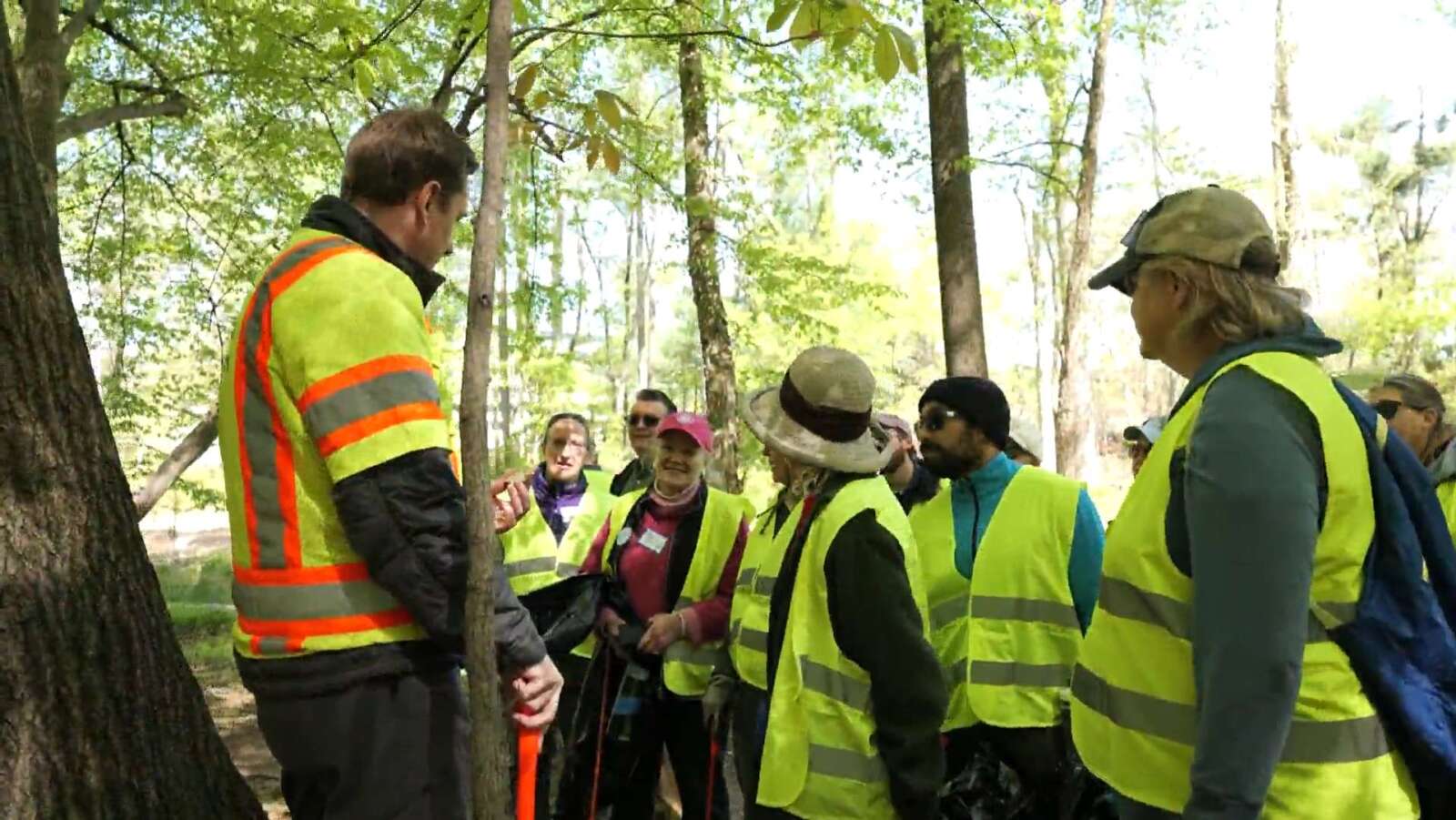
The continued development of Tysons doesn’t have to come at the expense of its remaining natural green space, argues a recent report on ways to preserve 65 acres of forest in the urban center.
A community task force has recommended two dozen actions that could help preserve and even enhance wooded areas collectively known as Tysons Forest, including tree plantings and clean-up efforts. Dated March 24, the report was formally accepted by the Fairfax County Board of Supervisors on April 16.
“Usually, task forces are not looking at preserving natural areas like this and enhancing them, but it was a really wonderful and very positive community-led effort,” Hunter Mill District Supervisor Walter Alcorn said at the board meeting.
Alcorn assembled the Tysons Forest Community Task Force last September to craft a plan for protecting the woods along Tysons’ southwestern edge. Spanning the Dulles Toll Road to Gosnell Road, the expanse includes the 33-acre Old Courthouse Spring Branch Stream Valley, the Ash Grove Historic Site and Raglan Road and Freedom Hill parks.
Chaired by resident Jack Russell, the task force counted residents, local building owners, office tenants, Fairfax County Park Authority staff and other county representatives, and conservation experts among its 23 members.
After meeting throughout the fall and winter, the group solidified recommendations that it hopes will enable humans and wildlife to coexist, while making Tysons Forest “sustainable and emerald green forever.”
Leading the proposals is the need for the county to officially recognize the stream valley corridor as Tysons Forest, including by adding wayfinding signage, and incorporate a pledge to protect the habitat in its Tysons Comprehensive Plan.
The task force also highlighted the importance of replenishing the area’s tree canopy, which it reported has declined by approximately 20-25% in the past five years. In addition to planting 200 wire-guarded trees and seedlings annually, the report suggests cutting down on the amount of invasive plants by at least 50% by 2028 and conducting counts of birds, bees and other wildlife to measure the area’s biodiversity.
Other notable recommendations include:
- Revive the Ashgrove Trail extension project and evaluate options for connecting it to the Vesper Trail south of Spring Hill Road
- Expand Tysons Forest by securing proffer contributions from developers and encouraging property owners to adopt ecologically friendly practices
- Maintain a safe and clean forest by requiring developers to mitigate run-off into streams, adding trash cans along walking trails and conducting regular trash cleanups
- Enlist local students as “green champions” by offering volunteer opportunities and including youth on future task force teams
- Create a website and events calendar for Tysons Forest
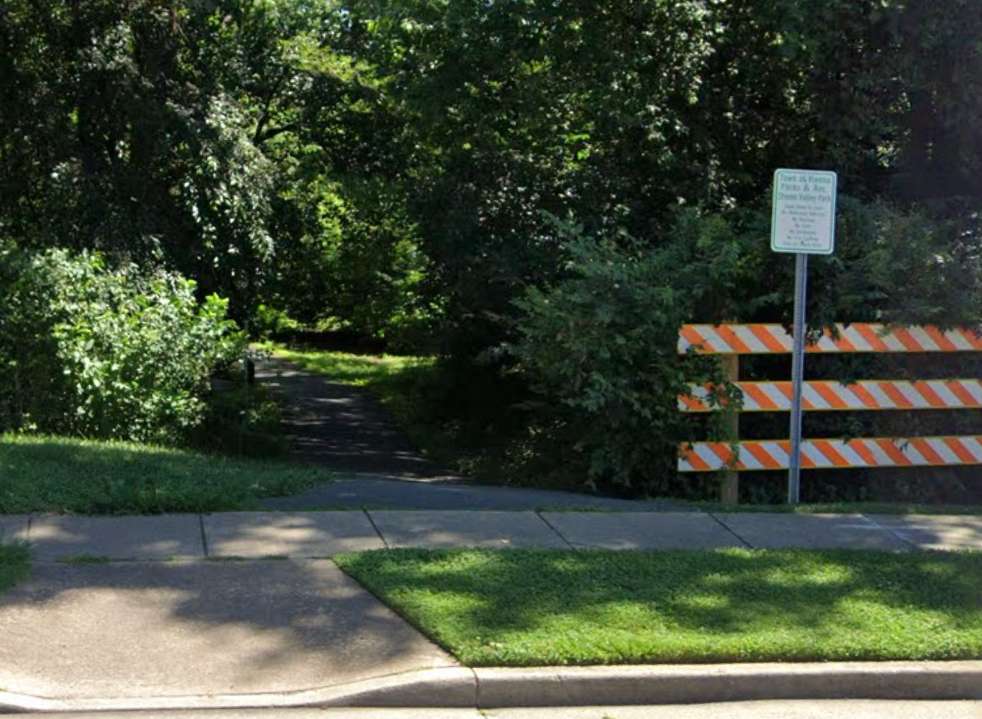
The Town of Vienna will take a critical step this coming Arbor Day toward replenishing its tree canopy, thanks to the late councilmember Maud Robinson.
During its March 4 meeting, the current Vienna Town Council gave staff the go-ahead to spend $50,000 from the Robinson Trust on a planting project that will add 145 trees along local streets and the East Creek Trail.
Established by Robinson’s estate after her death in 2019, the over $8 million trust was mostly intended to support new sidewalks, but a portion was set aside for town beautification projects, specifically tree plantings.
“This is an important contribution to the restoration of our canopy, which probably all of us here desire,” Councilmember Chuck Anderson said before the vote. “…We have to thank Maud for leaving the money specifically for this purpose, so let’s spend it.”
The allocated funds will cover the planting of 70 trees along six streets and 75 trees along East Creek Trail, which is located at the intersection of Ayr Hill Avenue NE and East Street NE.
The streets — Brentwood Court NW, Blair Court NW, Witness Court NW, Counsellor Drive NW, Carters Glen SW and Moorefield Road SW — were chosen based on a town-wide tree inventory completed last year, according to Vienna Parks and Recreation Director Leslie Herman.
Conducted by the urban forestry consultant PlanIT Geo, the final inventory identified over 10,000 trees in Vienna, including around 4,200 that were in need of maintenance, stump grinding, pest or disease control, or removal. The report also pointed out more than 1,200 potential planting locations for street trees.
Herman told the town council that the new trees funded by this project will be a mix of native and non-native species, since native species don’t always thrive in the narrow strip of land between sidewalk and road that’s available for street trees.
“Street trees grow in a variety of harsh conditions,” she said. “There are a number of considerations that go into the selection of street trees in Vienna, to include poor soil, lack of moisture, road de-icing salts, pollution, urination by dogs, overhead utility avoidance, selection for a root system that’s compatible with nearby sidewalks, curb-and-gutter, lawn mowers and the opening and closing of doors.”
The plantings are expected to begin this spring and finish in November, depending on the weather.
Volunteers will be enlisted for the planting effort along East Creek Trail as part of the town’s Arbor Day festivities. An event is being organized for the morning of April 27, a day after the official Arbor Day Celebration at the same site on April 26.
Residents slated to get street trees in front of their homes will be notified in advance of the plantings, Herman said.
Bolstering the town’s tree canopy has become a priority of the Vienna Town Council since an assessment released in October 2022 found that it had lost approximately 163 acres — or 13% — of its tree cover since 2011.
A zoning code amendment that would establish new standards for preserving and adding trees has been in the works since May 2023, but a decision on whether to adopt it has been repeatedly deferred, partly due to a debate over how the ordinance should be organized and partly in anticipation of new state legislation.
A bill championed by state Sen. Saddam Salim would’ve allowed the town to set 10-year tree canopy requirements for developers, instead of the 20-year time frame currently expected. The legislation appeared on track for approval, passing the State Senate on a 28-12 vote, but it was defeated 52-48 in the House of Delegates on Feb. 28, falling short of the 67 “yes” votes needed to pass.
In the wake of the bill’s failure, the town council held a conference session on the proposed tree ordinance on March 4, but it remains unclear when the measure might get an official vote.
Image via Google Maps
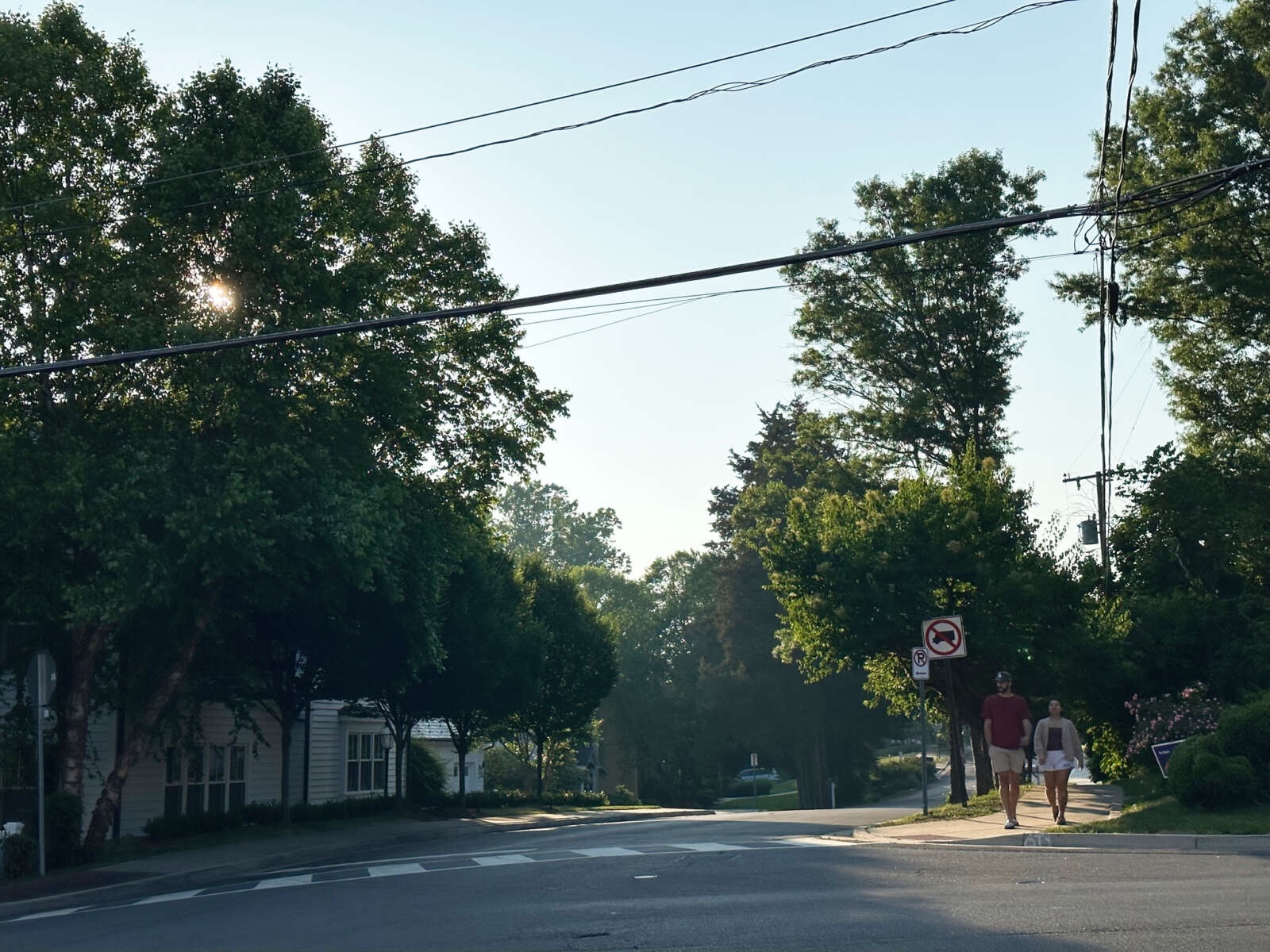
Future developers in Vienna may have half as much time to cultivate tree shade on their properties.
The Virginia State Senate recently passed legislation that would enable Vienna to adopt 10-year tree canopy requirements in place of the current 20-year time frame, getting the town a step closer to accomplishing one of its top priorities for the past couple of years.
Senate Bill 316 from Sen. Saddam Azlan Salim (D-37) passed the Senate 28-12 on Jan. 25 and now awaits a vote in the House of Delegates, which could send it to Gov. Glenn Youngkin.
“The Town of Vienna has made this a priority in their legislative agenda for the past few years,” Salim’s office told FFXnow. “Virginia is a Dillon Rule state, [meaning] localities are required to get permission from the state legislature to do things.”
An identical bill filed in the House by Del. Holly Seibold (D-12) got rolled into a larger bill dealing with tree preservation. Read before the full House for the first time yesterday (Tuesday), House Bill 1100 would let all localities require developers to conserve trees, an authority currently only available to Northern Virginia.
The Vienna Town Council has been advocating for the ability to strengthen its tree canopy rules for developers since at least 2017, but the issue took on new urgency after a 2022 study found that the town had lost 13% of its tree canopy in the past decade.
The request to amend state law so the town could offer credits for the preservation of medium and large trees or require developers to cover at least 20% of a lot with tree canopy in 10 years, rather than 20, topped the council’s legislative agenda for the General Assembly’s 2024 session.
Right now, the 10-year canopy requirement is only an option for Williamsburg City and localities like Fairfax County that had adopted the provision before 1990, according to the Town of Vienna.
In the legislative agenda, the town council also called for the option to protect trees notable for their age, species, size “or other special significance”:
Given the vital role that trees play in the protecting our urban environments, and their contributions to the local look and feel of neighborhoods, decisions over tree policies should be determined at the local level, reflecting the wishes of the local residents. Trees canopy requirements or incentives should also be included in acceptable best management practices for storm water management.
While Salim’s bill only addresses the time frame for developers, the Vienna Town Council is poised to adopt other tree preservation standards that it already has the authority to implement.
The proposed ordinances would increase the minimum tree-canopy requirement from 20% to 25% lot coverage, require developers to preserve trees when possible to meet their requirements, create a tree planting fund and replace the town’s tree board with an appointed commission.
The ordinances were expected to get a vote on Feb. 26, but the town council agreed on Monday (Feb. 5) to defer advertising their intended adoption, partly to see what happens with the state legislation and partly to give members more time to comment on the final draft.
Councilmember Chuck Anderson, who proposed the deferral, admitted he needed more time to read the ordinances after a separate bill to allow a casino in Tysons “sucked all the oxygen out of the room.” Vienna publicly opposed the casino bill, which was officially postponed to 2025 by the Senate’s finance committee yesterday (Tuesday).
“Since this is so important to me personally, I really want to spend some time looking at the final draft and to make sure it’s basically as good as possible,” Anderson said of the tree ordinances. “…I’m not looking for major changes at all, but I would just like one more shot at looking at this carefully before we enact this.”
The council will now vote on publicizing its intent to adopt the ordinances at its Feb. 26 meeting. The council’s first meeting after the required 10-day waiting period will be on March 18.
Vienna Parks and Recreation Department Director Leslie Herman and Town Attorney Steven Briglia confirmed to FFXnow that the outcome of the state legislation won’t affect the council’s ability to adopt its tree canopy preservation ordinances.
“Should the bill pass, and Vienna is allowed to require a 10-year time frame for tree canopy requirements, the newly adopted Town code amendments to the ordinance will need to be amended by the Council to reflect that change,” Herman said.
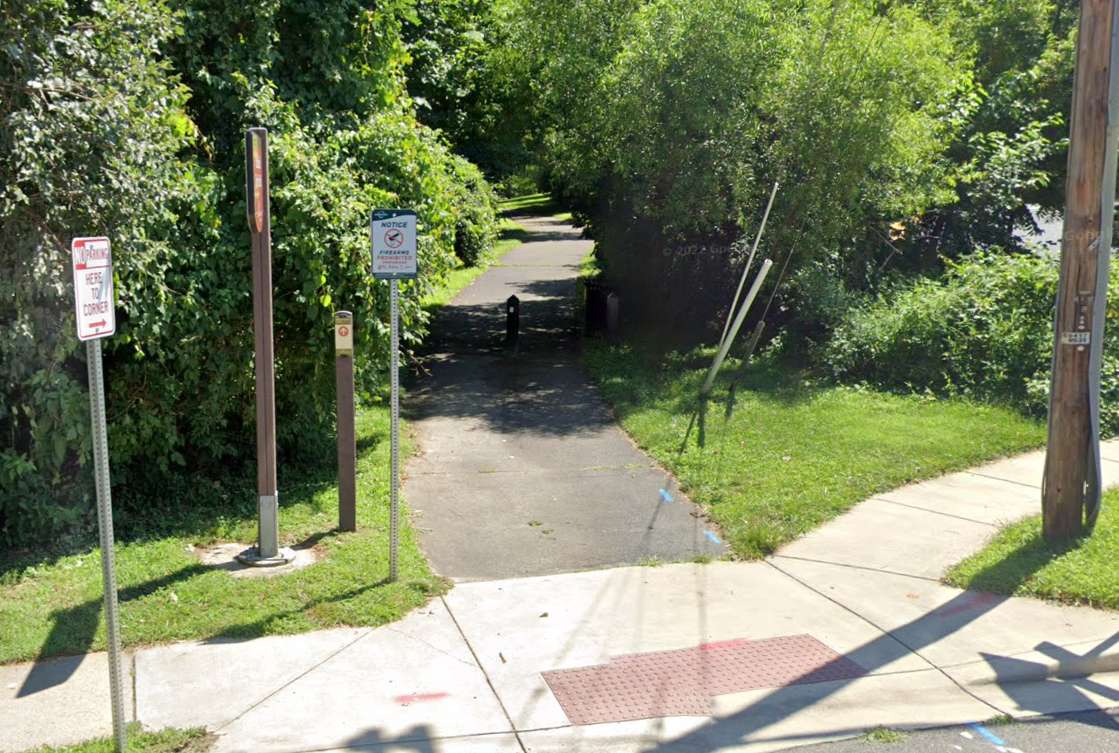
Fairfax City will complete the George Snyder Trail as planned after all.
In response to some community concerns, the Fairfax City Council discussed changing the pedestrian and bicycle project’s scope or even canceling it altogether during its meeting on Tuesday (Jan. 23). But council members failed to agree on any of the proposed alternatives, allowing the city to stay the course by default.
“None of the resolutions received enough support to change the current trail alignment,” City of Fairfax spokesperson Matthew Kaiser confirmed to FFXnow. “Staff will continue to acquire the needed land and come back to council in six months or so for [a construction] bid approval.”
The city has acquired rights-of-way for two of five needed parcels, Fairfax City Transportation Director Wendy Sanford told the council.
Over a decade in the making, the planned trail will run along the south side of Accotink Creek for about 1.8 miles from Chain Bridge Road (Route 123) to Fairfax Blvd (Route 50), connecting the existing George Snyder Trail to the I-66 shared-use path that’s slated to finish this spring.
However, some residents and environmental groups, including the Audubon Society of Northern Virginia, have objected to the proposed route for the 10-foot-wide trail, which will wind through a wooded area and require removing 553 trees. A segment in Shiloh Street Park that would’ve eliminated another 11 trees has been dropped from the plan, according to a city staff report.
The city has said 858 trees and 815 shrubs, all native species, will be planted to offset the lost trees.
Though the design is complete, Sanford said the council could cancel the project, realign the trail east of Fair Woods Parkway to use existing roads more, or construct only the segment west of Fair Woods Parkway.
Staff recommended either sticking with the existing plan or building only the western segment. If it cancels the project, the city would have to repay at least $395,000 in federal funding out of the $3 million it has spent so far, potentially putting it at a disadvantage for receiving future awards, Sanford said.
Most of the project’s $17.6 million budget comes from a concession fee that the I-66 Outside the Beltway toll lanes operator agreed to provide for transportation improvements in the corridor. Sanford said it’s unclear if any of that will need to be returned.
Revising the trail’s eastern segments would require restarting the design and engineering process, according to Sanford.
“This would delay the project, cause additional costs in engineering and potentially higher construction costs due to inflation when we do get to construction,” she told the council. “There’s also no assurance of feasibility for the new alignment or public support for any of the alternatives.”
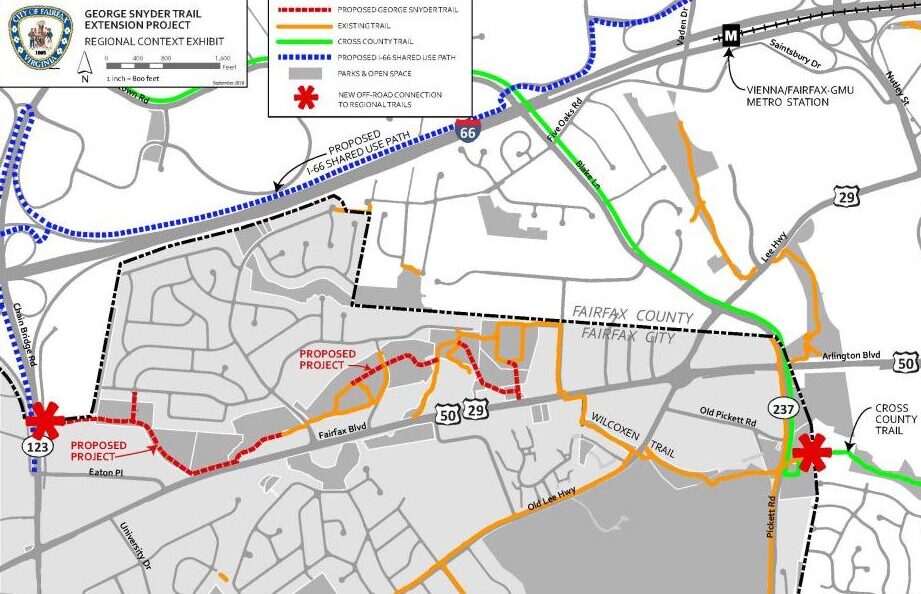
Councilmember Jeffrey Greenfield proposed building the western portion with two tweaks: merging it with the sidewalk on Route 50 where they run parallel and possibly rerouting it through WillowWood Plaza, an office complex on Eaton Place under review for redevelopment as housing. Read More
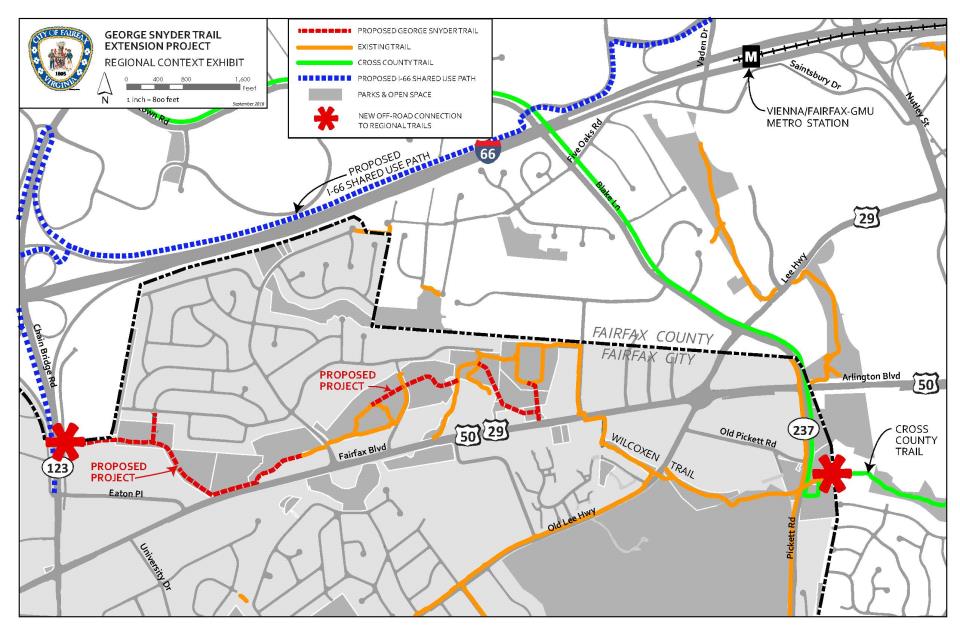
The Fairfax City Council will vote on the future of a much-debated trail planned in the heart of the city later this month.
During a meeting on Tuesday (Jan. 9), the city’s transportation director, Wendy Sanford, presented the council with options for proceeding with the George Snyder Trail project, which will complete a 2-mile trail along the southern side of Accotink Creek between Chain Bridge Road (Route 123) and Fairfax Blvd (Route 50).
Plans for the Snyder trail have been underway for more than a decade, but the project has drawn some criticism from environmentalists who say it will eliminate hundreds of trees, negatively impacting the area’s woodlands.
A group of city residents sent an email to the city council and staff on Jan. 2 urging them to consider alternatives that would add a trail or bicycle lanes on existing streets, such as Fairfax Blvd, Cardinal Road or Eaton Place.
The planned route has gotten support from bicycling advocates, who say it’ll fill a missing link in the region’s bicycle network, particularly in the I-66 corridor.
In a presentation, staff recommended the council either continue with the proposed changes or modify it by only constructing the western portion from Chain Bridge Road to Fair Woods Parkway.
“To continue with the project as proposed, that would mean putting the project out to bid,” Sanford explained. “We have the 100% [design] plans to continue with the right-of-way acquisition.”
If the city cancels the project, Sanford said it would be required to repay some or all of the $3 million it has already spent, potentially affecting the city’s ability to be awarded funds for future projects.
Sanford noted that the suggested modification would reduce the overall cost, while still delivering some of the trail. However, Councilmember So Lim pushed for a cancellation, saying she thinks “it’s all or nothing.”
Councilmember D. Thomas Ross disagreed and said cancelling the project could have a negative impact on taxpayers.
“We’ve heard consistently the concerns about cost of operation and development and maintenance of the trail if it’s completed as proposed,” he said. “It’s going to be nothing compared to what we hear when we start talking about paying up to $3 million.”
Mayor Catherine Reed was also against canceling the project, but said she won’t participate in the scheduled vote on Jan. 23 unless there’s a tie.
“What what we understand about environmental impact is significant. No one is saying here that there’s no impact in building this trail, but we have heard it described as destroying a forest,” Reed said.
Anna Safford, the city’s urban forester, acknowledged the environmental concerns surrounding the trail, but said recreation helps to protect land.
“If you don’t use land, you lose land, but at the same time, recreation isn’t conservation,” Safford said. “And there is a very big difference in the land types along this corridor.” Read More
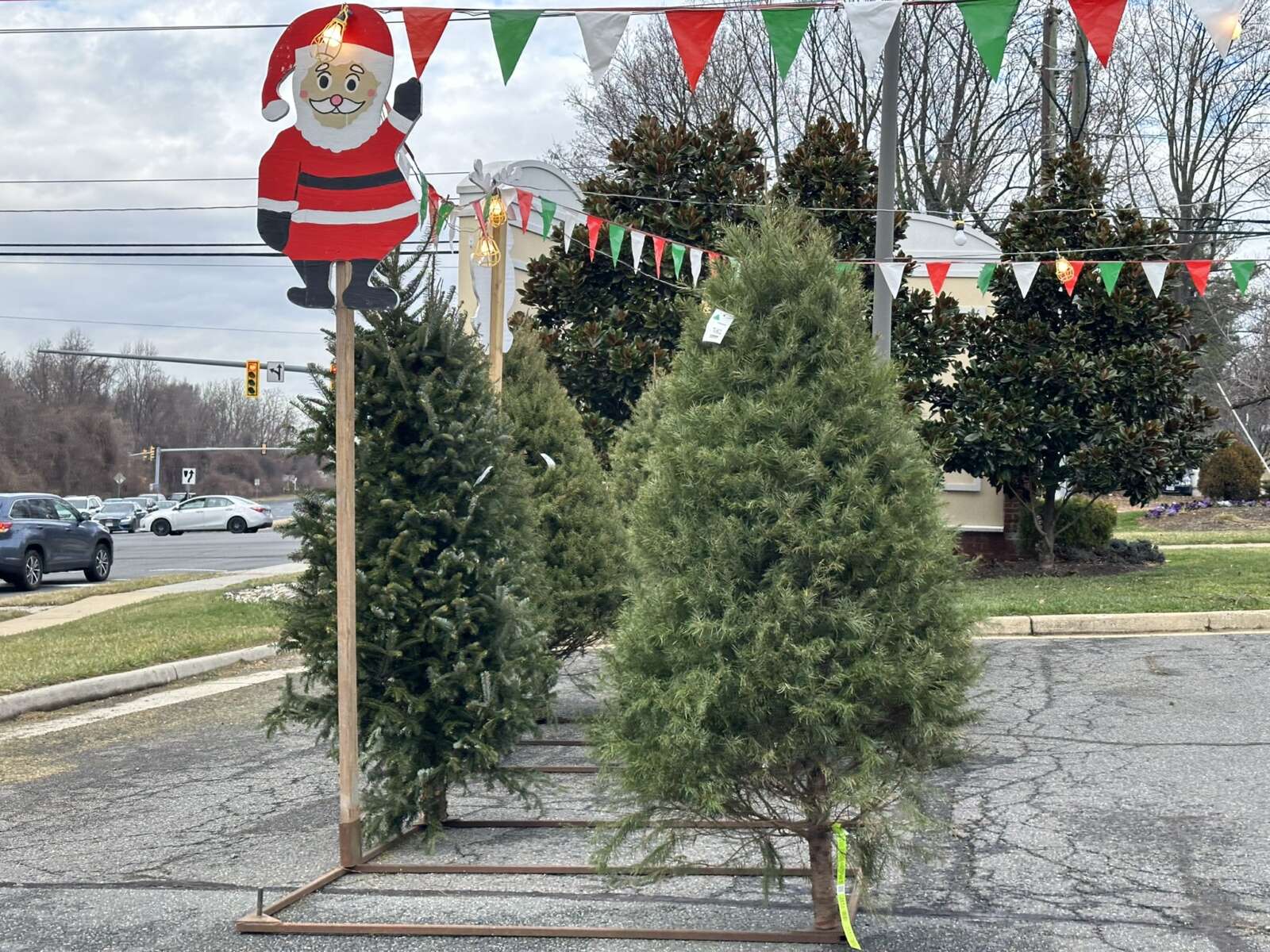
Christmas Day has come and gone, but the trees festooned with lights and tinsel for the occasion need to stay up for another week if you’re counting on a curbside pickup.
For the roughly 10% of residents served by Fairfax County, the Department of Public Works and Environmental Services will collect live trees for recycling from Jan. 1-13 as part of its regular waste services.
Private trash companies licensed to operate in the county are also required to pick up trees 8 feet or shorter that are set outside in single-family and townhouse communities during the first two weeks in January.
“At the end of the two-week collection period, residents serviced by the County can schedule a brush pick-up for trees,” DPWES said in a news release. “Those who utilize a private company should contact their hauler with questions regarding collection of Christmas trees following the two-week period for special tree collection.”
Community members can also dispose of their trees directly at the I-66 Transfer Station (4618 West Ox Road) and I-95 Landfill Complex (9850 Furnace Road) in Lorton during their operating hours, though both have a $9 recycling fee for Christmas trees.
Trees that get recycled are turned into mulch that the county offers to residents.
Lights, ornaments, stands and other accessories must be removed before disposal.
“DPWES asks residents to dispose of tree lights in their recycling or trash because they get tangled in our machinery and their components are bad for the environment,” the department said, noting that lights can be dropped off at the county’s e-waste disposal sites or potentially local hardware stores.
For artificial trees, the county advises donating them to a charitable organization or church if they’re still in good condition. Local options include the Springfield nonprofit ECHO, which accepts Christmas trees in November and December, and GreenDrop sites, which also accept decorations.
In the Town of Vienna, curbside collection services will be provided for natural Christmas trees throughout January, and Town of Herndon residents can get trees picked up on their regularly scheduled trash day from Jan. 3-5 and Jan. 10-12.
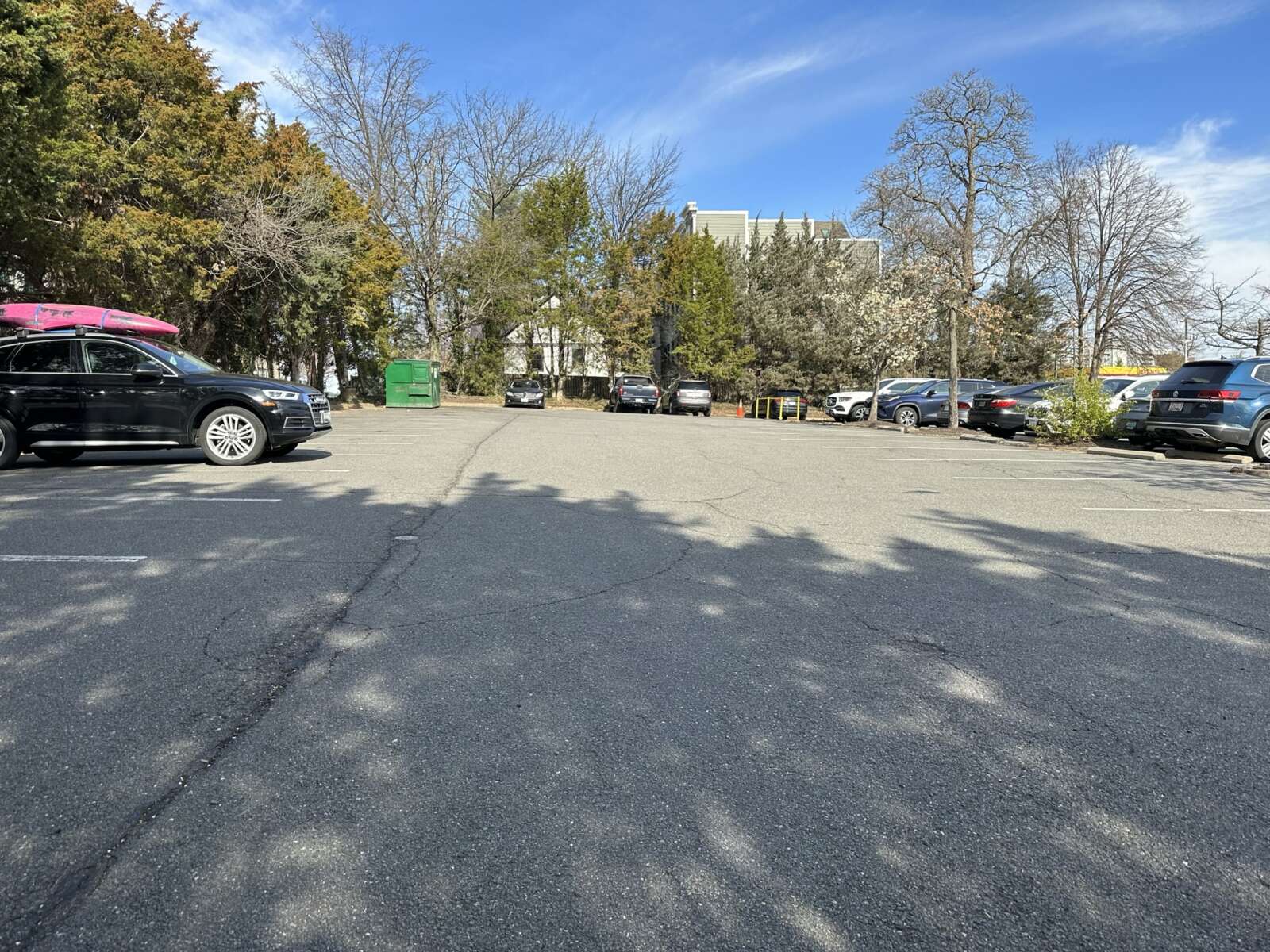
Fairfax County is moving forward with updates to its landscaping and screening requirements along streets and parking lots.
The Fairfax County Planning Commission recommended the approval of changes to the ordinance at a meeting on Dec. 6. If fully approved, it would be the first major change to the ordinance in 40 years and could make parking lots greener.
Planning staff proposed the update to the Fairfax County Board of Supervisors at a land use policy committee meeting back in May.
At the planning commission public hearing, Sara Morgan with the Department of Planning and Zoning, said the introduction of “street frontage landscaping” would require developers to provide a planting strip on private property parallel to a public or private street. Single-family dwellings would be exempted.
“It is on private property. It’s 10-foot wide with one tree for every 30 feet,” Morgan said.
The current ordinance requires trees to be installed at any surface parking lot with 20 or more spaces. The update would expand that requirement to surface lots with 10 or more parking spaces. It would also increase the required tree coverage from 5% to 10% “to address some of the urban heat-island effects and other environmental impacts,” Morgan said.
For parking garages, the new ordinance would establish shade structure requirements. New garages would need to have 10% of their top decks covered with shade.
“The parking structure could be a canopy, a canopy with vegetative roofs, solar collections systems or trees,” Morgan said.
To incentivize the use of solar power, developers that add a solar system on top of a garage would only need to cover 5% of the structure instead of 10%, Morgan added.
The Great Falls Citizens Association raised an objection to the substitution of shade structures as an alternative to natural landscaping.
Morgan said this was included because often, trees planted on top of parking structures do not grow to the extent where they provide adequate shade.
“So, we are looking at ways where we can achieve that shade through the means of possible trees, but also through the canopies or the solar collection systems,” she said.
Other changes in the ordinance include a preference for native tree species as well as environmentally tolerant species. During outreach, the county heard from individuals who wanted more species that have the ability to withstand high heat and high-drought flooding, according to Morgan.
Braddock District Commissioner Mary Cortina proposed amending the ordinance to specify that preference be given to environmentally tolerant species “where appropriate for site conditions.” The commission unanimously approved the amendment.
Cortina praised the timing of the proposed changes, calling it a good decision to follow up the county’s approval this fall of new off-street parking standards
“And I think this decision alone is really going to change how these parking lots look,” she said.
The ordinance will now go to the Board of Supervisors for approval on Jan. 23.
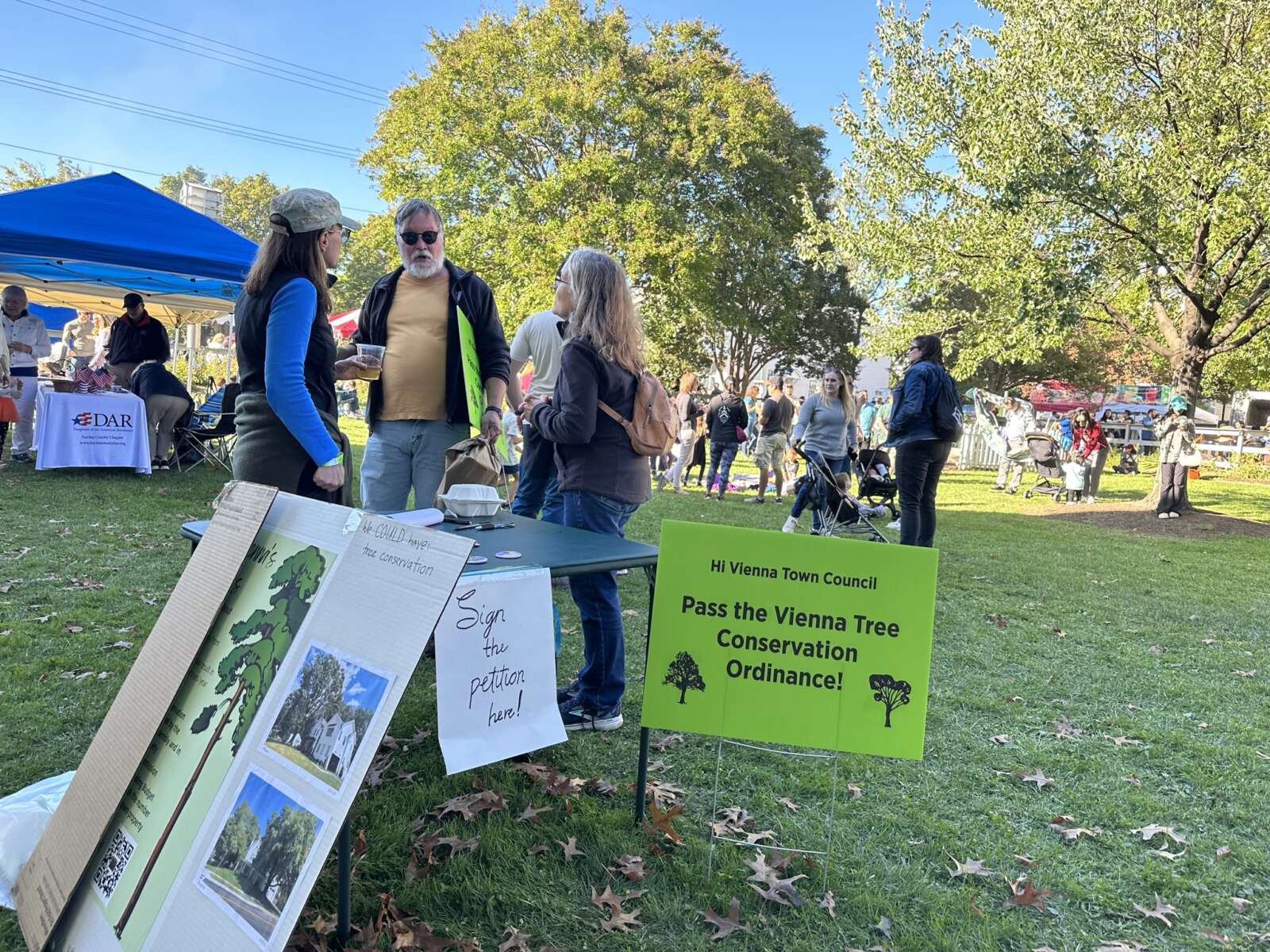
The future of Vienna’s trees will rest on a new town council.
When it met on Monday (Nov. 13), the current Vienna Town Council was scheduled to finalize a proposal aimed at preserving and enhancing the town’s tree canopy, which has declined over the past decade.
But after a public hearing on noise and other agenda items pushed the meeting past midnight, the council voted instead to discuss the tree conservation ordinance in a 5 p.m. conference session before its meeting on Dec. 4 — leaving no time for a formal vote before the end of the year, to the disappointment of some council members.
“I think it’s a shame that it’s come down to this, because this is something that’s been known for a long time, and it just has not been acted upon to the level it should’ve been in my opinion,” said Councilmember Steve Potter, who is retiring due to health challenges. “…We’re not doing what we said we were going to do, and that’s the part that bothers me, because it’s just not right.”
Designated a top priority for 2023 by the council, the tree ordinance will increase requirements for canopy coverage — from 20 to 25% for large, single-family residential lots, for example — and introduce new standards and incentives to encourage developers to plant and preserve trees.
If adopted, the conservation ordinance would be just the second one in Virginia, following in the footsteps of Fairfax County, according to a memo from Vienna Director of Planning and Zoning David Levy. Like most localities, Vienna currently requires that developers replace trees, rather than preserve them.
However, the council is still deciding the best approach to implementing the new rules.
One option recommended by Town Attorney Steve Briglia would update the town code chapters on zoning, subdivisions and the Conservation and Sustainability Commission (CSC), whose duties include serving as the town’s tree board. Under this approach, the requirements would still be enforced by the planning and zoning department.
An alternative proposed by Vienna resident and Kirkland & Ellis LLP attorney Brian Land, whose firm was hired to conduct a pro bono analysis in 2020, would create a new chapter in the town code with all tree canopy and preservation requirements. The ordinance would be implemented by the Department of Parks and Recreation and establish a tree commission independent of the CSC.
Tree advocates who testified before the council at a public hearing on Oct. 23 “overwhelmingly” favored Land’s proposal, arguing that it would be broader in scope and make a clearer statement on the importance of trees to Vienna, Gazette Leader reported.
The town attorney recommended giving the planning director authority to allow deviations from canopy requirements in cases where they would cause “unnecessary or unreasonable hardship to the developer.” It also doesn’t require trees to be monitored or inspected after construction.
The Vienna Planning Commission issued a recommendation last Wednesday (Nov. 8) largely supporting Briglia’s proposal with a few tweaks, including a requirement that developers seeking to deviate from the canopy standards justify their request and an added provision for inspecting trees before and after they’re planted similar to what Land suggested.
“This language is consistent with current practice and codifying it will clarify the process for builders and property owners,” the commission said in a memo for the town council.
The council gave no indication on Monday regarding which direction it plans to take but instead spent half an hour debating whether to schedule a conference session on the issue next month, knowing that an actual vote won’t come until a new council takes office.
Mayor Linda Colbert and the three council members who sought reelection this year — Howard Springsteen, Chuck Anderson and Ray Brill — are all set to return. They will be joined by Planning Commissioner Jessica Ramakis, Board of Architectural Review Chair Roy Baldwin and budget analyst Sandra Allen, according to election results finalized Tuesday (Nov. 14).
In response to complaints about the delay on a tree conservation ordinance vote, Colbert noted that the council had accomplished other objectives, including the adoption of an updated zoning code and approval of sidewalk projects facing an October 2024 deadline.
“I don’t think anybody’s trying to push this off,” Colbert said. “I think we have done a tremendous amount of work, this council has, and there’s only so many minutes or hours in a day. Nothing’s lost…We’ve done a lot of work on the trees. It just takes a lot of time.”
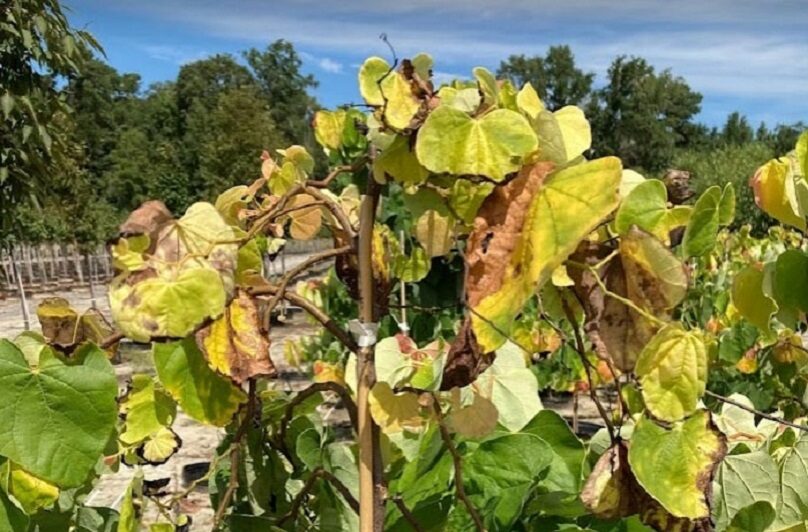
Any Fairfax County residents who recently bought a budding tree or shrub may want to keep an eye on its leaves.
A relatively new disease called vascular streak dieback is killing plants from nurseries in Virginia and five other states, the Department of Public Works and Environmental Services’ (DPWES) Urban Forest Management Division says.
“Dieback may look like yellowing or paling of the leaves’ green color (leaf chlorosis), brown or scorched leaf margins and stunting and/or wilting of current year’s growth,” DPWES said in a press release on Tuesday (Oct. 3).
In Virginia, the plants that appear to be most susceptible to the disease are maple, dogwood and redbud trees, according to Virginia Tech and the Virginia Cooperative Extension (VEC), which have cataloged 21 different affected woody ornamental plant species, as of March.
First detected in cacao in Papua New Guinea during the 1960s, vascular streak dieback was mostly confined to southeast Asia until the past couple of years. The Virginia Department of Agriculture and Consumer Services (VDACS) confirmed that the disease had emerged in the state last year.
Researchers have traced the disease to a fungus called Ceratobasidium theobromae, whose spores get carried from plant to plant by the wind, according to DPWES.
“After a spore infects a leaf, it travels into the branch and the main stem’s woody tissue, eventually killing the plant,” the department says. “Researchers continue to study VSD, and the fungus related to it, to find ways to prevent infection and the potential spread into the natural environment.”
Available data on how to prevent VSD is limited, but Virginia Tech and the VEC say it can help to minimize stress on plants by ensuring they have the right amount of soil, water and other conditions needed to stay healthy.
Here’s more from DPWES:
Virgina Cooperative Extension recommends that nurseries ensure best management practices of plant stock to prevent chances of infection. Residents looking for trees in nurseries may consider asking nursery staff about vascular streak dieback and if the internal woody tissue may safely be checked for VSD before purchasing. Also, look for any signs of scorched leaves and buds or dieback of young stems. If VSD is suspected in a recent purchase report it to the Virginia Cooperative Extension and dispose of the plant material correctly to prevent its potential spread. Plants, or the suspected live branches, also may be bagged and either taken or mailed to the Extension, where the disease can be positively identified. If mailing, a two-day delivery is best to avoid damage to live tissue.
The county’s urban forest management team has also been combatting a beech leaf disease that emerged in the area last fall and the invasive spotted lanternfly, which feeds on trees, shrubs and herbs “in unusually large numbers,” DPWES has said.
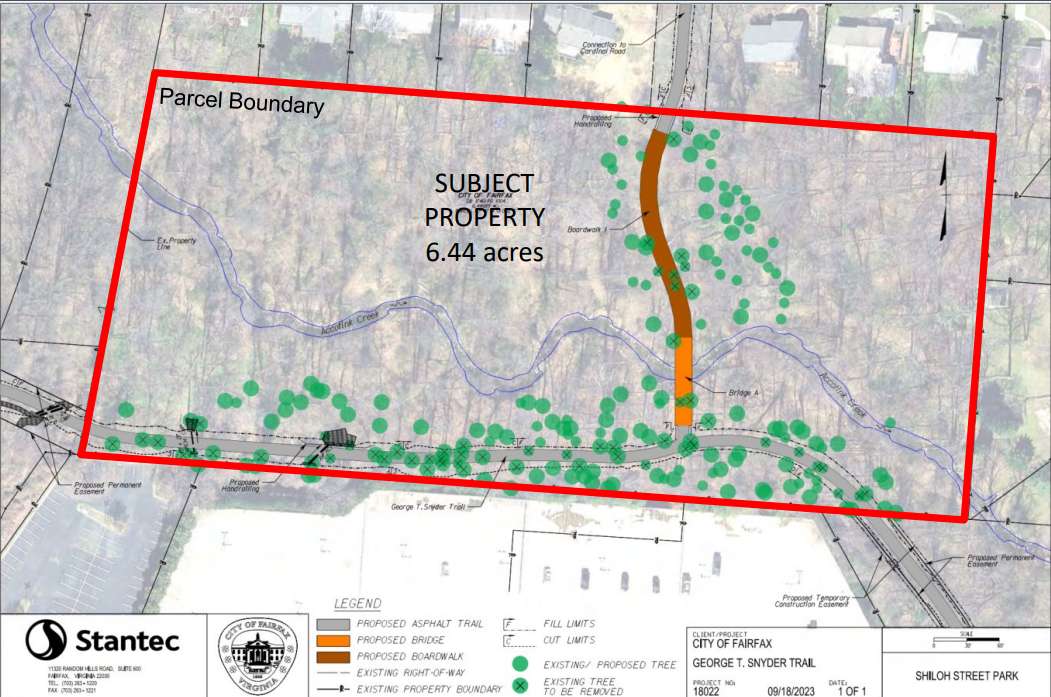
(Updated at 3:45 p.m.) A years-long effort to build a pedestrian and bicycle trail along Fairfax Blvd (Route 50) is facing a roadblock.
At a public hearing last Tuesday (Sept. 26), the Fairfax City Council deferred action on a special use permit for nearly 12,000 square feet of trail in Shiloh Street Park (10400 Shiloh Street). The affected area requires the permit because it is zoned for residential development.
The Shiloh Street Park passageway, which would include asphalt pavement, a boardwalk and a bridge over the Accotink Creek, would join the partially-constructed George Snyder Trail. Plans for the Snyder trail have been in the works for more than a decade.
Per a July presentation from city staff, the final version of the trail will be 1.78 miles long and offer a route for pedestrians and cyclists parallel to Fairfax Blvd from Chain Bridge Road (Route 123) to Draper Drive, connecting to the Wilcoxon Park trail.
The special use permit request for Shiloh Street Park now appears on the agenda for the council’s Oct. 10 meeting, where it will not require a public hearing. The vote to defer action was unanimous.
Councilmember D. Thomas Ross said he supported the deferral to give the council time to gather additional information and reflect on concerns raised by community members.
Councilmember Kate Doyle Feingold said the proposal was developed to use funding, rather than to serve residents.
Much of the Snyder trail’s $18.8 million estimated cost will be covered by money from the state’s I-66 Outside the Beltway project, which funds 16 projects approved by the Commonwealth Transportation Board with the recommendation of the Northern Virginia Transportation Authority.
“What we need to do is design things that the community and residents want, design things that protect our natural spaces, that make our residents feel safe and comfortable, places people love to go, like Daniels Run Trail,” Doyle Feingold said.
Among other concerns, she said the project would “take down an unnecessary hundreds of trees”
City staff estimate the Shiloh Street Park portion of the project would require removing 59 trees, while the overall project would require removing 568 trees — a prospect that has fueled opposition to the trail from some community members.
A mitigation plan to offset the prospective tree losses would plant 858 trees and 815 shrubs — all native species — in the project area, including 518 trees and 353 shrubs in the resource protection area, a city spokesperson says.
During the public hearing, four individuals who said they live in the Mosby Woods neighborhood near Shiloh Street Park spoke against having an access point to the trail near their homes, citing crime.
Ross said he recognized those concerns, and the city is taking action to address them. Ultimately, though, he remained supportive of the trail.
“From a trail perspective, and from our parks and our open space, opening them up to public access can be a good thing. It adds visibility. It adds public use,” he said.
Ross also said there has been “strong community support” for the trail over the years of its development.
The Fairfax Alliance for Better Bicycling called on riders to support trail construction ahead of a city council work session in July.
The vote on the Shiloh Street Park special use permit is not the last action the city council will take on the trail project this year. If the permit is approved, the body will vote this winter to award a contract for construction, which is scheduled for spring 2024, per city staff’s July presentation.

